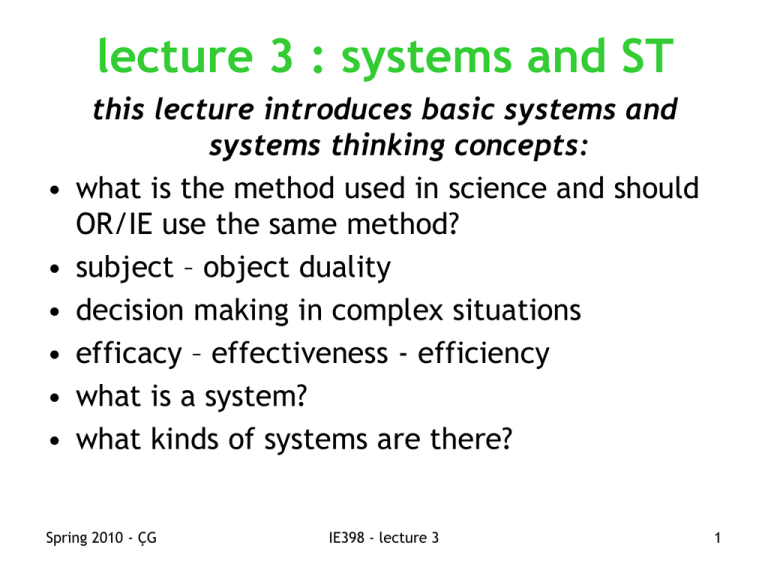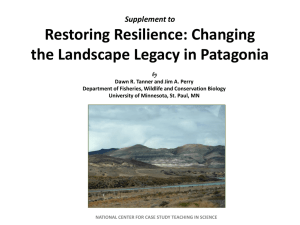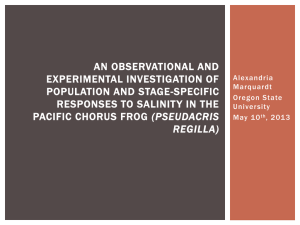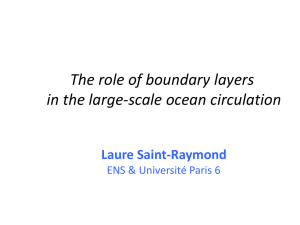lecture 2: systems thinking - Middle East Technical University
advertisement

lecture 3 : systems and ST • • • • • • this lecture introduces basic systems and systems thinking concepts: what is the method used in science and should OR/IE use the same method? subject – object duality decision making in complex situations efficacy – effectiveness - efficiency what is a system? what kinds of systems are there? Spring 2010 - ÇG IE398 - lecture 3 1 what method is used in science? Aristotle looked at the world as a living being: parts of the world could only be understood in terms of their relationship with each other and with the whole • this is a holistic (ie. systemic) and also a teleological view of the world (teleology is the doctrine that says there is a purpose to everything; it explains phenomena by the purpose they serve rather than by postulated causes) • so ST dominated Western thought for more than 2000 years, even though it was not called ST Spring 2010 - ÇG IE398 - lecture 3 2 • then came the Enligthenment that marked the beginning of modernity, the modern and presnt period of history • modernity started with the emergence of empirical sciences, when teleology was replaced by Cartesian mechanism, based on the philosophy of René Descartes (1596-1650) • Isaac Newton (1642-1727) developed and carried this type of thinking to great success; he has had the greatest influence on the shaping of the modern world, on how we live and understand the world Spring 2010 - ÇG IE398 - lecture 3 3 • the Newtonian perspective of the world is reductive rather than holistic; it assumes that analysis is the only means to gain knowledge • reductionism is the reduction of all phenomena to simple, unidirectional causal relationships between variables rather than interactions that can only be explained in terms of the functioning of the whole • the Oxford Dictionary says: reduction is the practice of analysing and describing a complex phenomenon, especially a mental, social, or biological phenomenon, in terms of its simple or fundamental constituents Spring 2010 - ÇG IE398 - lecture 3 4 • this Newtonian, or the mechanistic paradigm dominated science until the middle of the 20th century and is still alive • the Oxford Dictionary says: paradigm is a world view underlying the theories and methodology of a particular scientific subject • we can also define a paradigm as the set of shared and formal assumptions about the nature of reality and our knowledge of it Spring 2010 - ÇG IE398 - lecture 3 5 • thus, as quoted in Jackson (1): “Each of us lives and works in organisations designed from Newtonian images of the universe. We manage by separating things into parts, we believe that influence occurs as a direct result of force exerted from one person to another, we engage in complex planning for a world that we keep expecting to be predictable, and we search continually for better methods of objectively perceiving the world (Wheatley, 1992, p. 6).” •Newtonian thinking emphasises cause-and-effect thinking, in contrast to systems thinking •it is a hard view of the world and is based on the assumption of subject-object duality Spring 2010 - ÇG IE398 - lecture 3 6 subject-object duality • Newtonian science is founded on the possibility of objective knowledge acquired through independent observation • the central idea is that of subject-object dualism • this refers to the separation of the observer (subject) from the observed (object); if the observer can observe independently of the observed, then observation can be objective • positivism and disciplinary sciences in general are strongly rooted in the assumption of objectivity • thus, positivism claims that scientific inquiry can be objective, ie. strictly free of personal preferences and value judgements and therefore able to provide true knowledge Spring 2010 - ÇG IE398 - lecture 3 7 • in the 20th century, positivist science and the Newtonian paradigm came under attack, as in the course of complexity studies • for example: – in quantum mechanics subatomic particles do not exist as independent things; they come into being and are observed only in relationship to something else; observation influences the observed – in biology it was understood that organisms are adaptive and co-evolutionary rather than mechanistic – in chemistry, disorder in dissipative systems is now seen as the source of new order, and growth is found in disequilibrium, not in balance Spring 2010 - ÇG IE398 - lecture 3 8 Spring 2010 - ÇG IE398 - lecture 3 9 • these “underlying currents are a movement toward holism, toward understanding the system as a system and emphasising the relationships that exist among seemingly discrete parts • when we view systems from this perspective, we enter an entirely new landscape of connections, of phenomena that cannot be reduced to simple causeand-effect, and of the constant flux of dynamic processes” (1) • it also means that in systems, the observer inevitably influences the observed since he must be part of the system; absolute objectivity is therefore impossible, subject-object dualism breaks down Spring 2010 - ÇG IE398 - lecture 3 10 increased complexity • despite these developments, the positivist – objectivist - disciplinary attitude still persists in science • by contrast, OR had an interdisciplinary character when it was first practiced and quickly became aware of the impossibility of value-free inquiry • today even everyday decision making faces complexity: – “Today's world has thus increased in complexity and interdependence to a point where the traditional methods of problem solving based on the cause-and-effect model cannot cope any longer.” (2) • the following examples illustrate the complexity that cause unexpected and undesirable consequences to outweigh expected benefits Spring 2010 - ÇG IE398 - lecture 3 11 1. the Aswan High Dam in Egypt – increased incidence of schistosomiasis – – – loss of fertile silt and the need for fertilisers salinisation loss of land and decline of sardine fisheries 2. deterioration of urban transport – – – – – – 3. suburbanisation and increased car ownership extension of the road network reduced demand for public transport increasing fares, declining service quality further shift toward private transportation traffic congestion assessment of unit production costs – – Spring 2010 - ÇG maximising efficiency of each machine centre Can result in high inventory carrying costs IE398 - lecture 3 12 Spring 2010 - ÇG IE398 - lecture 3 13 efficacy–effectiveness–efficiency • efficacy : does the means work? e.g. adding another machine to the assembly line may or may not increase efficacy • efficiency : is resource use minimised? ie. maintaining effectiveness with fewer resources used • • effectiveness : will longerm goals be attained? concern about efficiency should not conflict with effectiveness (e.g. reducing inventories to save costs might cause loss of sales and revenue ) • efficiency should complement effectiveness Spring 2010 - ÇG IE398 - lecture 3 14 a counterintutive production example Spring 2010 - ÇG IE398 - lecture 3 15 produce more of the higher margin item: 3 units of A, 2 units of B; total profit = 3 X 90 + 2 X 60 = 390 produce more of the lower margin item: 2 units of A, 4 units of B total profit = 2 X 90 + 4 X 60 = 420 Spring 2010 - ÇG IE398 - lecture 3 16 systems • systems are everywhere; some varieties are: natural systems: e.g. the solar system, a frog, a girl, an ecosystem abstract systems: e.g. an algebra, the number system social systems: e.g. a pruduction system, a human activity system • the ontological (out there) vs. the epistemological (inside us) view; e.g. – an electric power supply system appears to be out-there – it will include generators, transmission and distribution lines, transformer stations etc. – but does it also include rivers and the electricity pricing system? • what the system will include or exclude will depend on how we define the system, on the purpose of inquiry • this can change for the same person too; e.g. a river system is not the same thing to an engineer when he is working and when he is vacationing Spring 2010 - ÇG IE398 - lecture 3 17 • although hard systems thinking can sometimes regard systems as out-there, it is often more useful to regard systems as inside-us, mental constructs • system definitions are therefore necessarily subjective, because they are influenced by: – the purposes and the interests of the observer – the Weltanschauung of the individual (each person interprets the world in terms of his/her own experiences and biases, ie. repeated patterns of experience lead to a complex set of beliefs and values through which we perceive the world; hence W is the taken-for-granted outlook of the world; a formalised W shared by a group of people is a paradigm) Spring 2010 - ÇG IE398 - lecture 3 18 “Suppose, for example, you were asked by the International Olympic Committee (IOC) to conduct a broad systems study of the future of the Olympic Games (…) It would be quickly apparent that there is no single account of the Games as the "system of concern" which would be generally acceptable: that "system" would be very differently described (and hence so would system objectives) by the IOC itself, by the host city, by would-be host cities, by athletes, by athletes' coaches, by officials, by spectators, by hot-dog sellers, by sponsors, by television companies, by television viewers who have no interest in athletics(…) This list could go on and on, and this is what happens as soon as you move outside technically defined problem situations and into human problem situations. (…) [This] illustrates that multiple conflicting objectives from multiple stakeholders are the norm in human situations.” Checkland and Holwell (2) Spring 2010 - ÇG IE398 - lecture 3 19 • in other words, reality can only be known through our perceptions of it, and these perceptions are necessarily shaped by our world view (ie. weltanschauung) • this means that subject-object duality cannot be assumed to hold • hence the only valid type of objectivity must be consensual, ie. socially decided • critical philosophy, unlike positivism, says that in science and in systems thinking, truth and validity claims can only be settled through a social process of negotiation Spring 2010 - ÇG IE398 - lecture 3 20 Dällenbach defines a system as follows: 1. 2. 3. 4. 5. 6. A system is an organized assembly of components. 'Organized' means that there exist special relationships between the components. The system does something, ie. it exhibits behaviours that are unique to the system. Each component contributes towards the behaviour of the system and its own behaviour is affected by being in the system. No component has an independent effect on the system. (A part that has an independent effect and is not affected by the system is an input. See (5) below.) The behaviour of the system is changed if any component is removed or leaves. Groups of components within the system may by themselves have properties (1), (2) and (3), ie. they may form subsystems. The system has an outside - an environment - which provides inputs into the system and receives outputs from the system. The system has been identified by someone to be of special interest for a given purpose. Spring 2010 - ÇG IE398 - lecture 3 21 Spring 2010 - ÇG IE398 - lecture 3 22 • the relevant environment – provides inputs to the transformation process – receives outputs from the transformation process that do not affect the system – inputs can be uncontrollable or controllable (ie. decision variables) – outputs include measures of performance • identification of the relevant environment requires setting boundaries • boundary judgements or boundary setting is perhaps the most critical step in ST Spring 2010 - ÇG IE398 - lecture 3 23 • we define the environment as that part of the world that lies beyond our control • but human activity systems do not have any real boundaries • we have to set the boundaries somewhere, so long as we don’t forget that those that are temporarily set, must be broadened endlessly • failure to do this will result in what Churchman (3) calls an environmental fallacy • an environmental fallacy will be committed if we focus our attention on one part of the system only and forget about the larger system of which it is a part • efficiency and effectiveness are again relevant here Spring 2010 - ÇG IE398 - lecture 3 24 • for example: – if we maximise the efficiency of each department of a hospital, it does not necessarily follow that the hospital will work effectively – a focus on minimising inventory costs will lead to a fallacy since inventories cannot be decided independently of production, of marketing, of procurement, of distribution, of maintenance etc. • Ackoff (4) defines environmental fallacy as follows: “Recall Peter Drucker’s observation of the difference between doing things right (efficiency) and doing the right thing (effectiveness). This distinction is fundamental. The righter we do the wrong thing, the wronger we become. If we made an error doing the wrong thing and correct it, we become wronger. (…) It is much better to do the right thing wrong than the wrong thing right” Spring 2010 - ÇG IE398 - lecture 3 25 examples of systems • a traffic system • a motorcar – – all parts fit together and interact so, is a car a system out-there? – its emergent property requires a driver, a purpose and a road network cars can be different things to different people: a means of transportation, a prestige symbol, a collection item etc. so a car is more meaningful as a human conceptualisation rather than a system out-there – – • a saw-mill Spring 2010 - ÇG IE398 - lecture 3 26 Spring 2010 - ÇG IE398 - lecture 3 27 two important decisions in systems thinking • when defining a system we have to decide: 1. where to set the boundary, this is called boundary setting, or a boundary judgement, or closure 2. what level of detail, or resolution, or scale to adopt, this is called separation of scales • these are the two most important decisions in systems thinking Spring 2010 - ÇG IE398 - lecture 3 28 boundary judgements • if the boundary is set too tight, there is the danger of losing sight of important system parts and interrelations • if the boundary is set too broad then there will be too many components and interrelations that will be difficult to handle and understand • an error committed by setting the boundary too tight is called an environmental fallacy, this is the most common and serious mistake made in IE/OR • for example: how do we asses an inventory holding cost? what environmental fallacies are likely to be committed? Spring 2010 - ÇG IE398 - lecture 3 29 hierarchies irrelevant environment environment for system 2 environment for system 1 suppliers system 1: narrow system of interest: marketing & sales cost minimising operations customers system 2 : wider system of interest Spring 2010 - ÇG IE398 - lecture 3 30 separation of scale the concept of “state” • this is a fundamental concept that cannot be defined any more than the concept of a “set” can be defined in mathematics • consider a physical system that transforms the single input represented by the time function v(t), into the single output represented by the time function y(t) • if we know the structures and processes that make up this system, then complete knowledge of v(t) over the interval (-∞,t] is sufficient to determine y(t) over the same time interval Spring 2010 - ÇG IE398 - lecture 3 31 • however if the input is known only over the time interval [to,t] then we need information at some time t1, where to ≤ t1 < t, in order to determine the output y(t) over the time interval [to,t] • this information constitutes the state of the system at time t1 ; it consists of the levels of all (structural and process) variables, or the state variables at time t1 , (e.g the state variables in dynamic programming; or the number of customers in a B&D queue) • in this sense, the state of the system is related to the memory of the system Spring 2010 - ÇG IE398 - lecture 3 32 • for another example of system-state, consider the solution of a linear differential equation with constant coefficients for t ≥ to • once the form of the complete solution is obtained in terms of arbitrary constants, these constants can be determined by the fact that the system must satisfy “boundary conditions” at time to; no other information is required • these boundary conditions can be termed the state of the system at time to Spring 2010 - ÇG IE398 - lecture 3 33 • intuitively, the state of a system separates its future from the past, so the state contains alI the relevant information concerning the past • the state of a system is represented by a vector showing the values of all state variables at time t • hence if the state vector is given for time t, then we have all the information there is to know about the system Spring 2010 - ÇG IE398 - lecture 3 34 • for an example consider a system of display consisting of 7x100 light bulbs that can allow 20 letters to be written by lighting some of the bulbs • this system will have 2700 ≈ 10210 different states (note that the number of atoms in the universe ≈ 1073 , which is infinitesimally smaller) • having such a huge state space is one reason why many systems are complex • fortunately not all the states of a system need be relevant for decision making, in many cases knowledge of aggregates or averages is sufficient Spring 2010 - ÇG IE398 - lecture 3 35 • for example, – when studying traffic problems, we don’t need to know the exact position and speed of all vehicles that are on the road-network at all times; often a knowledge of time-averages is good enough – a civil engineer designing a bridge does not need to know the state vector of all molecules that make up the bridge, knowing aggregate properties such as tensile and ductile strength etc. is sufficient • this reduction in the number of relevant system states is achived by separation of scales • that is, by deciding what level of detail is relevant for decision making Spring 2010 - ÇG IE398 - lecture 3 36 Spring 2010 - ÇG IE398 - lecture 3 37 • sometimes, in extreme cases the scale can be so large that the system is defined as a black box when, – not all the detail of the transformation process is needed, and – a black box representation is sufficient – which shows only the i/p and the o/p e.g. logs Spring 2010 - ÇG T IE398 - lecture 3 sales revenue 38 emergence • a good alternative definition of a system can be given in terms of emergence: a system is a set of interrelated components with emergent properties • an emergent property usually appears at higher levels of scale as a result of interactions at lower levels • human activity systems are often established in order to produce desired emergent properties (eg. a car-androad network transportation) • though they can also produce undesired emergent properties (eg. the same network noise and pollution) Spring 2010 - ÇG IE398 - lecture 3 39 Spring 2010 - ÇG IE398 - lecture 3 40 references 1. M.C.Jackson (2000) “Systems approaches to management” Kluwer ( available as an e-book in METU Library) 2. 3. 4. M. Pidd (2004) “Systems modelling” Wiley W. Churchman (1979) “The systems approach and its enemies” Basic Books R. Ackoff; J. Pourdehnad (2001) “On misdirected systems” Systems research and behavioral science, 18, pp:199-205 Spring 2010 - ÇG IE398 - lecture 3 41







